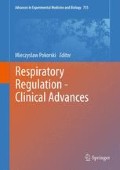Abstract
High flow nasal insufflations (NI) can improve gas exchange and alleviate dyspnea in patients with acute respiratory failure. In the present study we investigated the effects of high flow nasal insufflations in COPD patients with chronic hypercapnic respiratory failure (HRF). Seventeen patients with severe COPD and HRF were recruited. We delivered a mixture of 20 L/min room air and 2 L/min O2 through a nasal cannula either into both nostrils (NI) or into one nostril (Partial NI). Respiratory pattern and PaCO2 responses under NI were compared with low flow oxygen of 2 L/min. High flow nasal insufflations led to a systematic reduction in respiratory rate from 19.8 ± 4.2 at baseline to 18.0 ± 4.7 during NI (p < 0.008) and 18.1 ± 5.2 breaths/min during Partial NI (P < 0.03). The mean group inspiratory duty cycle (TI/TT) and mean group PaCO2 remained constant between all experimental conditions. Individual responses to NI were heterogeneous: six patients demonstrated marked reductions in respiratory rate (>20% fall from baseline), another group (n = 6) demonstrated no change in respiratory rate but marked reductions in arterial carbon dioxide of more than 8 mmHg. In conclusion, high flow (20 L/min) nasal insufflations of warm and humidified air during wakefulness for 45 min reduced respiratory rate without deterioration of hypercapnia. Our data indicate that high flow NI improved efficiency of breathing and may be used as an adjunct to low flow oxygen for preventing hypercapnic respiratory failure in severely ill COPD patients.
Access this chapter
Tax calculation will be finalised at checkout
Purchases are for personal use only
References
Anthonisen, N. R. (1983). Long-term oxygen therapy. Annals of Internal Medicine, 99, 519–527.
Clini, E., Sturani, C., Rossi, A., Viaggi, S., Corrado, A., Donner, C. F., & Ambrosino, N. (2002). The Italian multicentre study on noninvasive ventilation in chronic obstructive pulmonary disease patients. European Respiratory Journal, 20, 529–538.
Fang, X., Wang, X., & Bai, C. (2011). COPD in China: The burden and importance of proper management. Chest, 139, 920–929.
Groves, N., & Tobin, A. (2007). High flow nasal oxygen generates positive airway pressure in adult volunteers. Australian Critical Care, 20, 126–131.
Halbert, R. J., Natoli, J. L., Gano, A., Badamgarav, E., Buist, A. S., & Mannino, D. M. (2006). Global burden of COPD: Systematic review and meta-analysis. European Respiratory Journal, 28, 523–532.
Jemal, A., Ward, E., Hao, Y., & Thun, M. (2005). Trends in the leading causes of death in the United States, 1970–2002. Journal of the American Medical Association, 294, 1255–1259.
Mathers, C. D., & Loncar, D. (2006). Projections of global mortality and burden of disease from 2002 to 2030. PLoS Medicine, 3, e442.
McEvoy, R. D., Pierce, R. J., Hillman, D., Esterman, A., Ellis, E. E., Catcheside, P. G., O’Donoghue, F. J., Barnes, D. J., & Grunstein, R. R. (2009). Australian trial of non-invasive Ventilation in Chronic Airflow Limitation (AVCAL) Study Group. Nocturnal non-invasive nasal ventilation in stable hypercapnic COPD: A randomised controlled trial. Thorax, 64, 561–566.
McGinley, B. M., Patil, S. P., Kirkness, J. P., Smith, P. L., Schwartz, A. R., & Schneider, H. (2007). A nasal cannula can be used to treat obstructive sleep apnea. American Journal of Respiratory and Critical Care Medicine, 15(176), 194–200.
McGinley, B., Halbower, A., Schwartz, A. R., Smith, P. L., Patil, S. P., & Schneider, H. (2009). Effect of a high-flow open nasal cannula system on obstructive sleep apnea in children. Pediatrics, 124, 179–188.
Nocturnal Oxygen Therapy Trial Group. (1980). Continuous or nocturnal oxygen therapy in hypoxemic chronic obstructive lung disease: A clinical trial. Annals of Internal Medicine, 93, 391–398.
Parke, R., McGuinness, S., & Eccleston, M. (2009). Nasal high-flow therapy delivers low level positive airway pressure. British Journal of Anaesthesia, 103, 886–890.
Report of the Medical Research Council Working Party. (1981). Long term domiciliary oxygen therapy in chronic hypoxic cor pulmonale complicating chronic bronchitis and emphysema. Lancet, 1, 681–686.
Roca, O., Riera, J., Torres, F., & Masclans, J. R. (2010). High-flow oxygen therapy in acute respiratory failure. Respiratory Care, 55, 408–413.
Schneider, H., O’Hearn, D. J., Leblanc, K., Smith, P. L., O’Donnell, C. P., Eisele, D. W., Peter, J. H., & Schwartz, A. R. (2000). High-flow transtracheal insufflation treats obstructive sleep apnea. A pilot study. American Journal of Respiratory and Critical Care Medicine, 161, 1869–1876.
Wijkstra, P. J., Lacasse, Y., Guyatt, G. H., Casanova, C., Gay, P. C., Meecham Jones, J., & Goldstein, R. S. (2003). A meta-analysis of nocturnal noninvasive positive pressure ventilation in patients with stable COPD. Chest, 124, 337–343.
Acknowledgments
Supported by P50 HL084945, HL105546, and TNI medical Freiburg, Germany.
Conflicts of Interest: The authors declare no conflicts of interest in relation to this article.
Author information
Authors and Affiliations
Corresponding author
Editor information
Editors and Affiliations
Rights and permissions
Copyright information
© 2013 Springer Science+Business Media Dordrecht
About this paper
Cite this paper
Nilius, G., Franke, KJ., Domanski, U., Rühle, KH., Kirkness, J.P., Schneider, H. (2013). Effects of Nasal Insufflation on Arterial Gas Exchange and Breathing Pattern in Patients with Chronic Obstructive Pulmonary Disease and Hypercapnic Respiratory Failure. In: Pokorski, M. (eds) Respiratory Regulation - Clinical Advances. Advances in Experimental Medicine and Biology, vol 755. Springer, Dordrecht. https://doi.org/10.1007/978-94-007-4546-9_4
Download citation
DOI: https://doi.org/10.1007/978-94-007-4546-9_4
Published:
Publisher Name: Springer, Dordrecht
Print ISBN: 978-94-007-4545-2
Online ISBN: 978-94-007-4546-9
eBook Packages: Biomedical and Life SciencesBiomedical and Life Sciences (R0)

